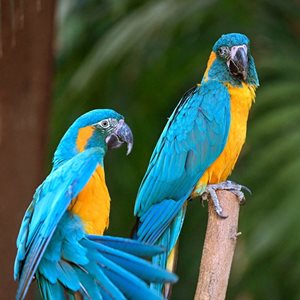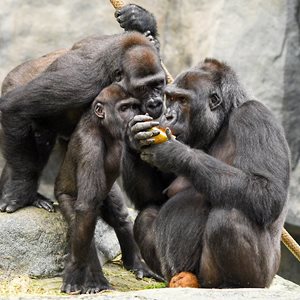The Chicago Zoological Society’s Animal Welfare Research Team continually searches for ways to expand our welfare monitoring toolkit. The key is to identify non-invasive welfare indicators that provide insight into an animal’s mental, emotional, and/or physical health. In recent years, welfare scientists working with farm, zoo, lab, and companion animals have recognized the value of tracking the vocal behavior of individual animals.
We are especially interested in what vocalizations can tell us about an animal’s emotions. Indeed, there is growing evidence from studies of both humans and non-humans that certain vocalizations—or even the rates, structures, or durations of certain calls—are associated with particular emotional states. Traditionally, researchers have focused on calls that reflect negative states or discomfort. For example, young animals often vocalize when separated from their mothers, many species emit alarm calls when disturbed, and it is common to hear loud, noisy screams or squawks during fights. Of course, we must keep in mind that some species (and/or individuals) may become less vocal or even remain silent when uncomfortable or frightened. For instance, when beluga whales are exposed to noise disturbances, their vocal activity may cease completely.
However, we also want to listen for calls that may reflect positive affective states or emotions. For instance, some species produce calls while searching for food, playing, engaging in grooming, or interacting in a friendly manner with groupmates. Many apes—including orangutans, bonobos, chimpanzees, gorillas, and siamangs— “laugh” while being tickled. Similarly, when tickled by humans, young rats emit ultrasonic chirps that are reminiscent of primitive human laughter. Just like humans, some species make sounds when “all is well” - i.e. when they appear to be comfortable, calm, or even content. For instance, a variety of mammals—including ring-tailed lemurs, tree shrews, raccoons, and various felid species—produce purrs or purr-like vocalizations while engaging in relaxed, friendly interactions. You may even be lucky enough to a hear a hen "sing!"
So how can welfare scientists and animal care professionals working in zoos/aquariums learn from the vocal behavior of our residents? We may be able to gain insight into an animal’s emotions and welfare state by monitoring the types, rates, and even the acoustic structures of calls. Fortunately, recent technological advances in the field of bioacoustics allow for vocal activity to be recorded with microphones, hydrophones, and animal-attached devices (e.g. collars). Certain types of software provide continuous monitoring and real-time sound analysis. Some systems automatically detect vocalizations, accurately assign calls to the correct caller, and generate alarms. For instance, an alarm may signal if an individual/group produces particular calls more or less frequently than usual. For zoos that do not have recording equipment or bioacoustics software, vocalizations can still serve as a valuable indicator of emotions or welfare. Indeed, zoo welfare researchers can add vocal behaviors to their systematic behavioral observations to track the rates of calls and to determine whether specific calls occur in certain contexts.
Ultimately, welfare researchers can learn a lot by investigating vocal behavior! We can conduct baseline monitoring for individual animals so that we can detect shifts in vocal production, which may reflect shifts in welfare status. It is also possible to design studies so we can evaluate the impact of animal introductions, transfers to new enclosures, and changes to the environment/routine. To build a comprehensive welfare monitoring toolkit, vocalizations can be combined with other non-invasive indicators, such as physiological biomarkers (e.g. fecal hormone measures) and behavioral states/events (e.g. play behavior, social grooming). The next time you are at Brookfield Zoo, keep your ears open for some purrs, coos, and laughs!
Dr. Jessica Whitham
Animal Welfare Biologist
Published February 5, 2024

